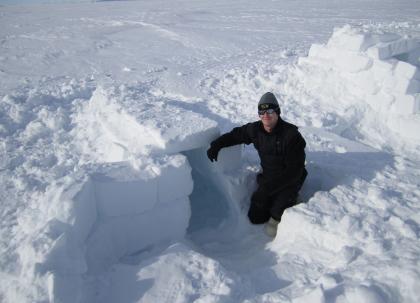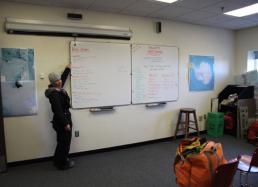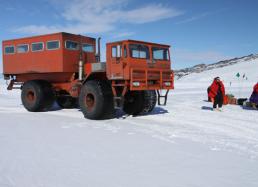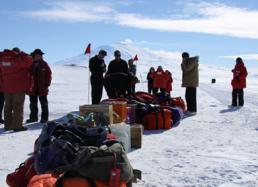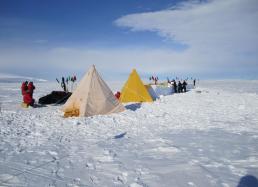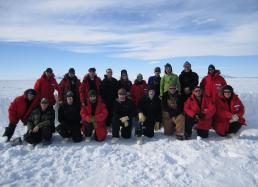4: "Happy Camper" Survival Training
After finally arriving in McMurdo and settling down in our new dormitory-style rooms, Josh and I got a quick night’s sleep before beginning "Happy Camper" training the next morning. "Happy Camper" is a two-day basic survival and snowcraft training program that all USAP participants traveling off McMurdo Station have to complete. It's designed to impart a set of skills that can be used to help survive and facilitate search and rescue in the event of any emergency where we might be stranded off base, or away from our remote field camp.
Our course begins in the Science Support Center classroom, where our exceptional instructors, Meghan and Jen, go over basic risk management and assessment and also cover how to avoid the most common cold-related illnesses or injuries we might face (see Photo #1 below.) Some of these concepts appear simple enough on the surface, but understanding and employing these strategies is key to a safe and successful field season. Even a brief reading of the history of Antarctic exploration provides numerous examples of how neglecting these details can be disastrous.
After donning our Extreme Cold Weather Gear, our class heads outside to load up into the Delta, a monstrous vehicle designed to travel over earth, ice, and snow (see Photo #2 below.) Our capable and congenial driver (also named Jen), takes us and our gear out of McMurdo Station, past New Zealand’s Scott Base, and out onto the ice shelf. This is where we’ll complete the rest of our training and make our frosty home for the night.
The ice shelf is essentially a portion of the glacier flowing off Ross Island. Further out from us is the transition between the ice shelf and actual sea ice. One of our first tasks is to review basic geography to help orient us to where we are on the ice, including identifying major landmarks (e.g., Scott Base, Castle Rock, Mt. Erebus), and cardinal directions (e.g., the region between Black and White Islands heads South). Understanding geography and weather patterns is critical for remote camps; for instance, knowing that the heaviest storms will blow in from the South helps us design the layout of our camp and set up our tents in the safest orientations (see Photo #3 below.)
After a quick lunch of sandwiches and cookies, we learn how to assemble and use our MSR WhisperLite stoves. Our instructors go over some basic trouble-shooting and repairs for the stoves, as well as tips for conserving fuel in the event of a survival situation. With stove basics out of the way, the next thing to do is set up several Scott tents (large, yellow triangular tents that really haven’t changed in design for almost one hundred years), as well as some mountain tents—we’ll be using both types of tents at our remote camp.
Our class also has to build a snow wall to protect the tents from the wind (this is where our knowledge of geography and weather pays off). The great thing about the ice shelf is that the ice is nice and sturdy, so we can actually cut out igloo-size building blocks with a saw and shovel. With seven tents in all, this makes for a lot of block-cutting and construction! (See Photo #4 below.)
At this point, our instructors set up several radio check-in times for our class and then leave us for the night. For those of us not sleeping in tents, after a warm dinner of re-hydrated fixin’s (Turkey Teriyaki—YUM!), we get the chance to design and sleep in our own snow shelter (see top photo.) Although a fun activity, learning this skill is an important part of Happy Camper, as there are many chances to be caught in a storm without a tent (or have a tent blow away). The most basic shelter is just big enough to stretch out and sleep in without contacting the frosty ice walls. With an overnight low of 9° Fahrenheit and peak winds of 26 knots, I definitely woke up chilly a few times in the middle of the night, but it was still the experience of a lifetime!
In the morning, we breakdown our camp and head into the instructor’s Jamesway hut for a few more lessons. We start by learning how to use VHF and HF radios, and going over basic radio terminology and etiquette (hint: it’s not like in the movies….) We also go over the contents and use of a "survival bag." These are large kits of survival equipment (tent, stove, sleeping bag) that we’ll be bringing with us every time we take a helicopter trip away from camp to our field sites.
Finally we come to the most fun part of "Happy Camper" training—Survival Scenarios! Anyone that has seen Werner Herzog’s fantastic documentary of McMurdo, "Encounters at the End of the World," is at least partially familiar with the ‘Bucket-head’ exercise, where participants wear buckets over their heads to simulate whiteout conditions and attempt to rescue a lost team member. (Check out Pete's new "Happy Camper Survival Training" video to see more about this amusing experience.) However, there are many other possible emergency scenarios to consider:
Let’s say your science team is traveling on a Delta across the ice shelf to a field site. Unfortunately, your Delta driver–let’s call him "Nate" (hypothetically), drank too much cough syrup that morning and inadvertently dozes off at the wheel, crashing the Delta against a rock outcrop. You manage to get yourselves and some equipment out of the Delta just before it is engulfed in flames. You’re miles from shelter. A storm is moving in. Nate is incapacitated. WHAT DO YOU DO?
Well, if you paid attention in your "Happy Camper" training, you know that time is of the essence. You divide up your team and have several members begin setting up your HF radio and antenna, while several others open your survival bag, begin setting up a tent to put Nate inside, and assembling a stove to melt ice for hot water.
Your quick thinking has paid off, and by the time the storm rolls in, you’ve already radioed McMurdo to alert them of your emergency and location, your team is inside a warm tent and protected by a snow wall, and you have plenty of hot water. One team member locates a single leftover packet of hot chocolate in his jacket pocket. Nate selfishly drinks it. You hate him, but you kept him alive.
With all kidding aside, hopefully you have an idea of how important this training can be to keeping our team safe during our field season, but also how exciting and fun it can be to camp out on the Antarctic ice. After successfully becoming "Happy Campers," Josh and I are headed back to McMurdo Station to meet Pete and the rest of our team (see Photo #5 below.)
Pete and I will keep you posted with some more dispatches of what life is like in McMurdo, and some of the amazing history in the area, so stay warm and stay tuned!
More soon,
Nate

